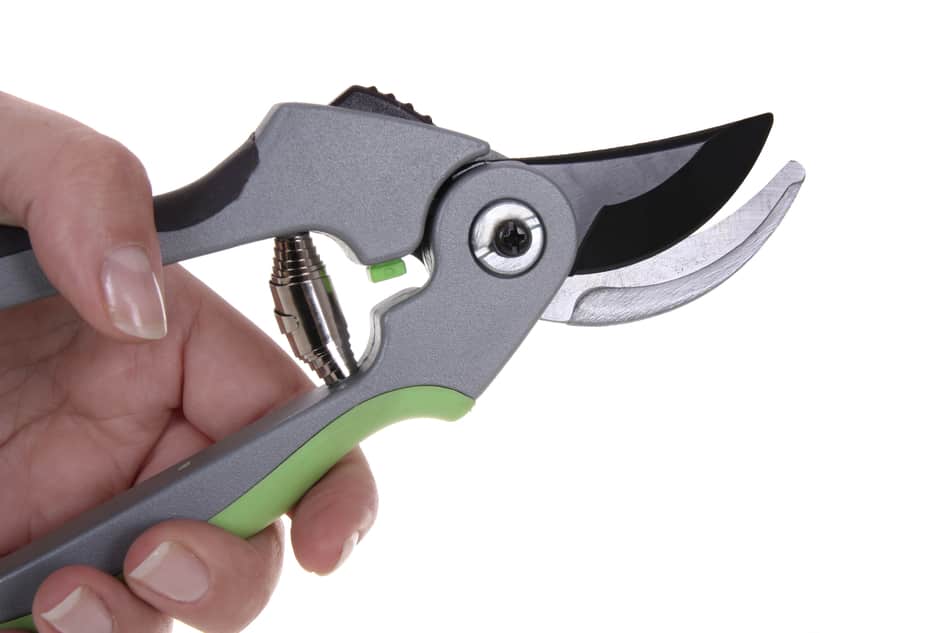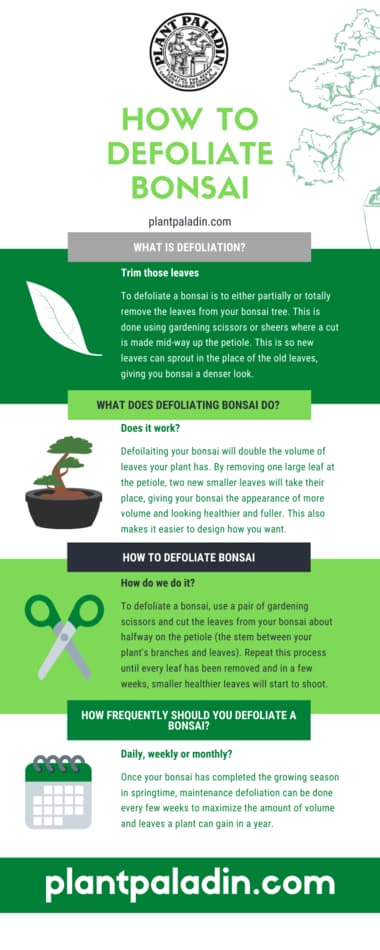This website is supported by its readers. If you click one of my links I may earn a commission. I am also a participant in the Amazon affiliates program and I will also earn a commission from qualified purchases.

One of the things I struggled with when I first started my journey in bonsai was my plants’ leaf size. My tree’s leaves were too big, blocking out some of the natural sunlight that the leaves under it so desperately needed. Luckily I came across the idea of defoliation which saved me literally hundreds of hours of unwanted stress.
To defoliate a bonsai, use a pair of gardening scissors and cut the leaves from your bonsai about halfway on the petiole (the stem between your plant’s branches and leaves). Repeat this process until every leaf has been removed and in a few weeks, smaller healthier leaves will start to shoot.
So when should you defoliate a bonsai? And is there any situation where this should be avoided? Keep reading to find out more!
A lot of you reading this post are just getting started with bonsai. You can find my recommendation for the best bonsai I found here (link takes you to Easternleaf) or the best faux bonsai here (link takes you to Amazon)
How to defoliate bonsai
So one of the hidden aces I had up my sleeve to help out any of the fading bonsai in my collection is defoliation.
Defoiliating can be one of the most effective ways to booster bonsai growth and help with styling ensuring you get the exact look that you want.
That being said there are a lot of misconceptions around exactly how to do this. Luckily, through a lot of hard work and (many) failed attempts I found the following steps are the perfect way to defoliate your bonsai:

Ensure your bonsai is old enough to support defoliation
The first step is easily one of the most important and yet possibly the most easily forgotten.
Whilst a lot of people rush towards defoliating their plants they don’t stop to ask themselves if this is something they should do.
If your bonsai is only a few years old or has weak roots and leaves then your bonsai likely needs a few more months and years until it can be a prime candidate to defoliate.
Secondly, if you have recently defoliated and pruned your bonsai already, then it might not be wise to do this again the very next month as a lot of the leaves and branches may still be a little weak or recovering from your last defoliate session
Invest in a good pair of scissors or sheers
The next step before you start cutting away is to ensure that you have a nice sharp pair of gardening scissors or sheers at your disposal in order to be as effective as possible.
The difference between a good pair of scissors and sheers vs a bad pair can make a world of difference, with cleaner cuts making it easier for new buds and leaves to form on the back of the defoliating process.
My recommendation then if you do not have any decent scissors or sheers at your disposal can be found below:
Gardening Scissors: Chopsticks and Succulents scissors ( link takes you to Amazon) – made of stainless steel and purpose-built for gardening and bonsai
Bonsai Sheers: Yafei Set ( link takes you to Amazon) – a complete set of sheers that are waterproof meaning you will never need to worry about getting any again.
Trim all the leaves from your bonsai
Now it’s time for the fun stuff – let’s be honest about half of you are into your new bonsai hobby for the fact that you get to cut things quite a lot!
The next step and one of the most important then, is to place your bonsai away from the others in your collection (after all you don’t want to have any accidents and defoliate bonsais that don’t need to be defoliated).
You then want to place your sheers or gardening scissors about halfway up the petiole – This is the little stem that connects the leaves of your bonsai to the branch of your tree.
You then want to make one sharp cut removing the leaf from the tree – aim to do this in one short swift cut.
What you should be left with is a small petiole sticking out of the branch with no leaf on the end of it.
You then want to repeat the process until all the leaves on your bonsai have been removed.
Ideally, start on the furthermost leaves on your tree and then slowly work your way in nearer to the center of your plant one branch at a time – this is because some of the inner leaves may not need removing at all.
Take your time
One of the tips that I had to learn the hard way is to take your time when defoliating your bonsai.
It can be super tempting to make large cuts to the leaves but when I have rushed the defoliating process in the past I made loads of errors like cutting off entire branches by mistake or damaging my scissors.
It’s important then that you take your time when defoliating your plant to ensure you are as accurate as possible when cutting.
So how long do the different sizes of bonsai take to defoliate? Luckily I’ve tested this out on my own bonsai. – After a few months of experience in keeping bonsai I found that these timings usually work best:
| Bonsai Size | Time to defoliate |
| Small | 1 hour |
| Medium | 2 hours |
| Large | 4 hours o 1 day |
Large bonsai trees in particular ( think of the bonsai that are over 1 meter) are going to be the most time consuming due to them having the most amount of leaves, so to ensure you don’t get stressed out or too tired in the process, you might want to split your defoliating sessions into several sessions.
Don’t forget about the aftercare
So once you have defoliated your bonsai, you might think that you can just move on but there are a few things you need to look into
First, after a few days, you want to make sure that the petioles are started to bud – this is a good sign that your defoliation has been successful.
Second of all consider wiring or styling your tree afterward – defoliating your tree is only part of the process, to truly get your bonsai to look the way you want it too these things will be required.
Finally, because some species used for bonsai may be weaker and more vulnerable once you have defoliated them, it’s important to check for signs of fungal infections or insect infestation.
The posts below should show how to help resolve that:
Now defoliating can be daunting so I’ve answered some of the more common questions below:
Can you use multiple defoliating sessions if your bonsai is big?
If your bonsai is large (1m and above) this can be time-consuming to defoliate in one sitting. It is recommended then to split the defoliating process over a few hours or a few sessions over the course of a few days to ensure you do not damage your tree or make any errors caused by fatigue.
Would you ever not defoliate the whole tree?
Defoliating a tree should be avoided when your tree is young and the branches, stems, and leaves are weak. If a number of the leaves are hidden by the larger leaves you are defoliating, then these leaves should not be removed to ensure they get enough sunlight for the rest of the season.
When should you defoliate a bonsai?
Defoliating a bonsai should be done later on in the growing season of a bonsai, typically early to mid-may. This is so your plants have time to grow new shoots and have time for their leaves to mature. If your plant’s leaves are overgrown and too large that is a good sign to start defoliating.
Should the majority of your leaves feel velvety and are darker then it’s not advisable that you defoliate them as they will likely be too young for the process.
“Defoliating bonsai can ensure you bonsai has a healthier set of leaves making it easier to style your bonsai”
What is defoliating bonsai?
To defoliate a bonsai is to either partially or totally remove the leaves from your bonsai tree. This is done using gardening scissors or sheers where a cut is made mid-way up the petiole. This is so new leaves can sprout in the place of the old leaves, giving you bonsai a denser look.
What does defoliating bonsai do?
Defoilaiting your bonsai will double the volume of leaves your plant has. By removing one large leaf at the petiole, two new smaller leaves will take their place, giving your bonsai the appearance of more volume and looking healthier and fuller. This also makes it easier to design how you want.
Defoliating your plant will also make your plant and its leaves come back stronger boosting the health of your plant overall.
How frequently should you defoliate a bonsai?
Once your bonsai has completed the growing season in springtime, maintenance defoliation can be done every few weeks to maximize the amount of volume and leaves a plant can gain in a year. It is not uncommon then for bonsai owners to defoliate 3 to 4 times per year during the summer.
That being said, I would only recommend doing this every few years as some species of bonsai may need a few years to recover from the process.
What plant species work best for defoliating bonsai
Chinese elm, ficus, and other traditional bonsai breeds work best for defoliating due to their leaves being easy to see and manipulate. Pine species are usually more difficult to defoliate due to the nature of their leaves.
This post was written by Fehed Nicass who has been passionate about bonsai for over 2 years. He currently resides in the Uk and works in sales.
